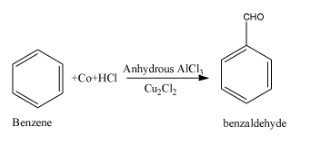Question
Question: The catalyst used in the Gattermann Koch reaction is: (a) anhydrous \(AlC{{l}_{3}}\) and \(C{{u}_{...
The catalyst used in the Gattermann Koch reaction is:
(a) anhydrous AlCl3 and Cu2Cl2
(b) anhydrous AlCl3
(c) Cu2Cl2
(d) CuCl2
Solution
The Gattermann Koch reaction is that reaction in which the ring compounds undergo formylation when treated with CO and HCl in the presence of two catalysts. Both are chlorides, the element with one chloride belongs to the boron family and the element with the other chloride is a transition element and with the help of this you can easily identify the catalyst. Now answer the statement accordingly.
Complete step by step solution: First of all, let’s discuss what is a catalyst. A catalyst is a substance which increases the rate of the chemical reaction and lowers the activation energy. They do not undergo any chemical change in its own composition i.e. it undergoes temporary changes and is not permanent.
Now discuss what is Gattermann-Koch reaction. In the Gattermann-Koch reaction, aromatic compounds are treated with the carbon monoxide and hydrochloric acid in the presence of a Lewis acid catalyst i.e. anhydrous aluminum chloride and Cu2Cl2 and finally, results in the formation of an aldehyde. The chemical reaction is supposed to occurs as follows;

Thus, the catalyst used in the Gattermann Koch reaction is anhydrous AlCl3 and Cu2Cl2.
So, option (a) is correct.
Note: Catalyst is not consumed during the reaction but is regenerated at the end of reaction. It is so because the catalyst is used only in one step and is regenerated in the other steps. Thus, remains unused in the reaction and doesn’t undergo any chemical and permanent changes during the reaction.
